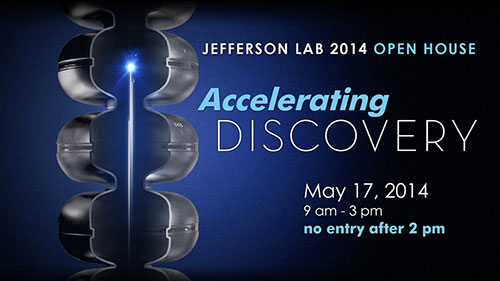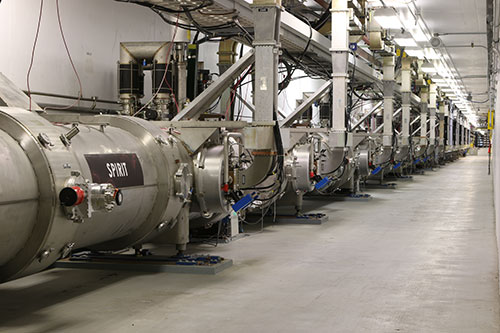
Jefferson Lab Gears up for 'Accelerating Discovery'
|
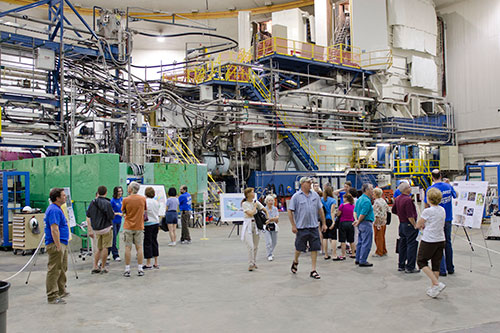 This slide show includes photos from the Jefferson Lab Open House held in May 2012. Between 7,000 and 8,000 visitors attended. They were able to see many of the unique research facilities and learn about the leading-edge projects underway at the lab, as well as participate in a variety of science education activities and catch the ever-popular Liquid Nitrogen Demonstration. Jefferson Lab will host a public open house on Saturday, May 17. It is the once every-other-year opportunity to spend the day exploring this world-class research facility. A number of the lab's facilities will be open and visitors will be able to see, hear about and experience some of the research effort underway at the lab. Attendees will be able to visit the upgraded CEBAF accelerator and the lab's newest experimental hall - Hall D - where state-of-the-art particle detectors are being installed. The accelerator upgrade and the new experimental area are a cornerstone of the lab's 12 GeV Upgrade project. The $338 million project, funded by the U.S. Department of Energy's Office of Science and scheduled for completion by Sept. 30, 2017, will allow the lab to continue as a world leader in nuclear physics research. The project is providing new and enhanced research capabilities for the 1,250 scientists, from more than 250 institutions, who come to Jefferson Lab to carry out experiments. The theme for this year’s open house is “Accelerating Discovery” in anticipation of bringing the upgraded CEBAF online......... more |
|
|
CEBAF Accelerator Achieves Major Step Toward 12 GeV Upgrade Commissioning
|
Site Being Prepped for the Tech Center Next Door
|
Lab Introduces New Users Group Chair, J. Arrington
|
||
|
|
||||
Below the Fold:
|
||||
|
|
||||
Jefferson Lab Gears up for 'Accelerating Discovery'
|
||||
|
|
||||
CEBAF Accelerator Achieves Major Step Toward
|
||||
|
|
||||
Site Being Prepped for the Tech Center Next Door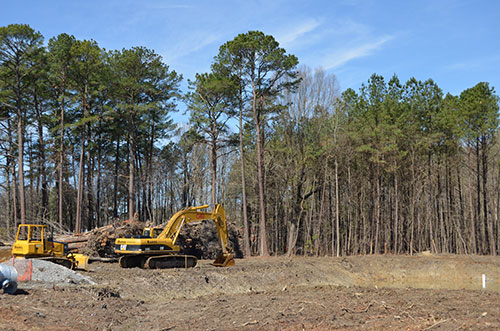 Heavy equipment is being used to prepare the land at the intersection of Oyster Point Road and Jefferson Avenue for construction of the Tech Center at Oyster Point. Big changes are coming to the lot next door. The large triangle of land bordered by Hogan Drive, Jefferson Avenue and Oyster Point Road will soon be developed into a mixed-use neighborhood, complete with retail shopping, restaurants, a residential area and commercial space. According to a website devoted to the new development, the theme for the Tech Center at Oyster Point According to the developer, W.M. Jordan, the center will feature more than 250 apartment homes, 50,000 square feet of specialty office space and 260,000 square feet of retail shops and restaurants. The first of the center's retail spaces is slated to open in the summer of 2015, including a 35,000 square-foot Whole Foods Market, which will be the second Whole Foods in Hampton Roads and the first store scheduled to open. The shopping area will also feature open-air seating, media centers and whiteboards to foster collaboration and discussion, and a grassy space for a farmer's market, concerts and other entertainment. In addition, wide sidewalks, such as the new sidewalk now in construction along Jefferson Avenue near Thimble Shoals, is planned to be continued along Jefferson Avenue to the Tech Center. While there has been a lot of focus on the Phase I aspect of the center, the shops and restaurants, work will also soon begin on Phase II. This phase features three- and four-story luxury apartment buildings (fall 2014), while Phase III includes the first portion of a research park to be managed by Virginia Tech, with buildings to house commercial and office spaces. These phases will also include the development of paths for walking, hiking and biking through the center. All of these amenities won't appear overnight. The developers are just beginning to prep the site for construction. Currently, W.M. Jordan crews are clearing trees and prepping two areas, along Hogan and Oyster Point Road, for sediment basins. As construction ramps up, Jefferson Lab employees, users and visitors can expect additional construction traffic around the site; this will include heavy equipment. However, the developers plan to mitigate any impacts to its neighbors, including Jefferson Lab. For instance, the developers say that the new design for traffic control will help to prevent traffic back-ups along Oyster Point and Jefferson during rush hour. In the next 16 months, they will extend Jefferson Avenue's right-turn lane for the intersection at Oyster Point. They will also add a new right-turn lane on Oyster Point just past the Jefferson Avenue intersection for access to the Tech Center. A traffic study has been conducted for the intersection of Jefferson Avenue and Oyster Point. Using data from the study, the developers will have the traffic light timed to ease congestion at the busy intersection. But perhaps the biggest change will be seen at Jefferson Lab's Hogan Drive entrance. Hogan Drive will feature as an important entrance into the Tech Center. To prevent traffic tie-ups on Hogan, W.M. Jordan plans to widen the two-lane road to four-lanes, which will initially extend just past the first entrance into the Tech Center. Later in the development, plans call for the four-lane to continue past the Rattley Road entrance onto lab property. The Hogan widening will have a major impact at the intersection of Hogan Road and Jefferson Avenue. Commuters will have three lanes on Hogan to choose from to access Jefferson Avenue: a left-turn lane, a combination left-turn and straight-through lane and a right-turn lane. The big changes will require roadwork on Hogan, Jefferson and Oyster Point. The bulk of the work on Hogan is anticipated to occur this summer. W.M. Jordan intends to leverage the school's summer vacation period to minimize impact on the many buses that travel Hogan Road to the Newport News City Schools depot (S.C.O.T. Center). The work will require shutting down one-half of Hogan Drive at a time. Traffic will be re-directed to the open side of Hogan during construction. Work is slated to begin in June. Another major traffic change will occur on Lawrence Drive. The portion of Lawrence that extends from the Applied Research Center parking lot entrance to Hogan Drive will be converted to a permanent one-way road. This portion of Lawrence Drive will become entrance only; no exit will be allowed from Lawrence onto Hogan. Additionally, this portion of Lawrence will be closed for a few weeks in late May for the installation of a sewer pipe for the Tech Center development. The closure dates will be announced as soon as the work has been scheduled. Jeffrey Johnson, recently hired by the Virginia Tech Corporate Research Center to oversee and manage the research park, says interest is already picking up. With plans to open the first of the park's buildings in 2015, the goal is to leverage ideas that come out of the many local technology centers, including Jefferson Lab. Meanwhile, expect the activity next door to ramp up in the coming months. Jefferson Lab's Public Affairs and Facilities Management & Logistics staff are in contact with the developers and will provide information on future impacts to the lab as the work progresses. |
||||
|
|
||||
Lab Introduces New Users Group Chair, J. Arrington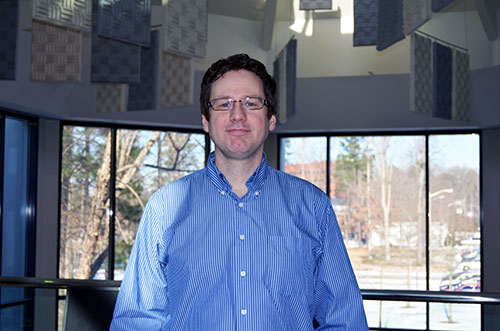 John Arrington, group leader of the Medium Energy Physics Group at Argonne National Lab and a long-time member of the Jefferson Lab community, is chair of Jefferson Lab’s Users Group Board of Directors. With a membership of more than 1,250 researchers, the Users Group exchanges information between users and lab staff, and it also offers advice to lab management on matters of policy affecting the development and use of lab facilities. John Arrington, the new chair of Jefferson Lab’s Users Group Board of Directors (UGBOD), has been a part of the lab community since 1993. At that time, he worked for three years in Hall C as a Caltech Ph.D. candidate. With the completion of his thesis, titled “Inclusive electron scattering from nuclei at x>1 and high Q^2” in 1998, he received a postdoctoral position at Argonne National Laboratory. He has been a staff physicist in the Medium Energy Physics Group since 2001 and was recently named group leader. Over the years, this Madison, Wis., native has received numerous awards, including a National Science Foundation Graduate Research Fellowship, the DNP Dissertation Award in Nuclear Physics, the Presidential Early Career Award for Science and Engineering, and he was named a Fellow of the American Physical Society in 2012. While the majority of Arrington’s research work at Jefferson Lab has been in Hall C and Hall A, he’s also been very involved in a variety of lab committees and collaborations; he served on the steering committees for Halls A and C, the 12 GeV Steering Committee, the electron ion collider nuclear QCD working group, and the Users Group Board of Directors. Now, as UGBOD chair, he has a particular interest in improving communication between the users and the lab. “As we enter a period of change and transition, the Users Group has a big role to play to bring together members from the whole organization,” he said. With a membership of more than 1,250 researchers - from 40 countries and representing more than 200 institutions – the Users Group has acted as a resource to encourage and assist scientists since its beginnings in 1984. It serves as a channel for the exchange of information between users and lab staff; offers advice and counsel to lab management on matters of policy affecting the development and use of lab facilities; supports, encourages and assists in the advancement of basic scientific knowledge; and promotes the most effective use of the lab's assets for the common good. “Our most important purpose is to be a conduit for information,” Arrington noted. “I think it’s easy for people who are at the lab a lot to assume that everyone knows or has heard all the latest plans and information, but that’s not always the case.” There are five at-large members on the Board of Directors, each with a focus on a particular sphere of interest: Quality of Life, Computing, Running Experiments and the Program Advisory Committee, Outreach, and Foreign Visitors. Three other members are devoted to specific constituencies: theory, postdocs and graduate students. These board members each serve a two-year term and half of the positions come up for election every year. The chair serves a total of four years – one as chair-elect, two as active chair, and one as past chair. The board has formal meetings with lab management and sends out results and highlights of those meetings to Users Group members. But, Arrington said, he hopes that during his tenure, a more on-going and casual communication and collaboration will take place. “People tend to focus on our formal activities and goals and our annual meeting,” he said. “I’d like to see people interacting with board members on a routine basis, sharing their ideas and concerns. I want them to feel free to contact us any time there’s something on their mind. The board members are generally available and responsive to the hopes and concerns of the user community.” In addition to the annual meeting, the UG also holds two smaller gatherings each year, at the American Physical Society (APS) April meeting and the fall Division of Nuclear Physics (DNP) meeting in order to reach people who wouldn't necessarily come to Jefferson Lab. The group gathers twice a year with lab management and advises the JSA Programs Committee on the relative merits of user-generated proposals for annual program funds. It also selects winners for the annual postdoc and thesis prizes. Many of the Users Group's programs and efforts are funded by the JSA Initiatives Fund Program, including the poster competition, thesis prizes, postdoc research grant, support for the annual Users Group meeting and for the DNP meetings, as well as travel assistance for junior scientists to scientific conferences, etc. Arrington and his wife, Ushma Kriplani, also a physicist, met in grad school and live in downtown Chicago. “We’re city people,” he said with a smile. “It’s good to be able to just step out the door and be in the midst of whatever we want to do.” As he settles into his role as chair of the Users Group Board of Directors, Arrington looks forward to the coming years. “Having been here for so many years, it’s nice to see how the lab has evolved. This is an exciting and challenging time to be here, and it’s a particularly interesting time to be chair – especially bringing the accelerator back on line and dealing with budget uncertainties. For me, it’s like being back on the ground floor, this time for stage two. There’s so much work to be done, and the UG is a core part of that.” For more information on the Users Group, visit: https://wiki.jlab.org/cugwiki By Judi Tull |
||||
|
|
||||
Below the Fold: |
||||
Quarks in the Looking Glass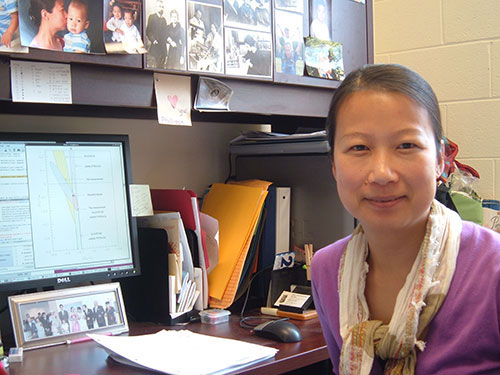 Xiaochao Zheng, an associate professor of experimental nuclear and particle physics at the University of Virginia, pauses while reviewing data from the experiment. Photo: University of Virginia From matching wings on butterflies to the repeating six-point pattern of snowflakes, symmetries echo through nature, even down to the smallest building blocks of matter. Since the discovery of quarks, the building blocks of protons and neutrons, physicists have been exploiting those symmetries to study quarks' intrinsic properties and to uncover what those properties can reveal about the physical laws that govern them. The result has also set new limits, in a way complementary to high-energy colliders such as the Large Hadron Collider at CERN, for the energies that researchers would need to access physics beyond the Standard Model. The Standard Model is a well-tested theory that, excluding gravity, describes the subatomic particles and their interactions, and physicists believe that peering beyond the Standard Model may help resolve many unanswered questions about the origins and underlying framework of our universe. The result was published in the Feb. 6 edition of Nature. The experiment probed properties of the mirror symmetry of quarks. In mirror symmetry, the characteristics of an object remain the same even if that object is flipped as though it were reflected in a mirror. The mirror symmetry of quarks can be probed by gauging their interactions with other particles through fundamental forces. Three of the four forces that mediate the interactions of quarks with other particles – gravity, electromagnetism and the strong force – are mirror-symmetric. However, the weak force – the fourth force – is not. That means that the intrinsic characteristics of quarks that determine how they interact through the weak force (called the weak couplings) are different from, for example, the electric charge for the electromagnetic force, the color charge for the strong force, and the mass for gravity. In Jefferson Lab's Experimental Hall A, experimenters measured the breaking of the mirror symmetry of quarks through the process of deep-inelastic scattering. A 6.067 GeV beam of electrons was sent into deuterium nuclei, the nuclei of an isotope of hydrogen that contain one neutron and one proton each (and thus an equal number of up and down quarks). "When it's deep-inelastic scattering, the momentum carried by the electron goes inside the nucleon and breaks it apart," said Xiaochao Zheng, an associate professor of physics at the University of Virginia and a spokesperson for the collaboration that conducted the experiment. To produce the effect of viewing the quarks through a mirror, half of the electrons sent into the deuterium were set to spin along the direction of their travel (like a right-handed screw), and the other half were set to spin in the opposite direction. About 170,000 million electrons that interacted with quarks in the nuclei through both the electromagnetic and the weak forces over a two-month period of running were identified in two High Resolution Spectrometers. "This is called an inclusive measurement, but that just means that you only measure the scattered electrons. So, we used both spectrometers, but each detecting electrons independently from the other. The challenging part is to identify the electrons as fast as they come," Zheng said. The experimenters found an asymmetry, or difference, in the number of electrons that interacted with the target when they were spinning in one direction versus the other. This asymmetry is due to the weak force between the electron and quarks in the target. The weak force experienced by quarks has two components. One is analogous to electric charge and has been measured well in previous experiments. The other component, related to the spin of the quark, has been clearly isolated for the first time in the Jefferson Lab experiment. Specifically, the present result led to a determination of the effective electron-quark weak coupling combination 2C2u – C2d that is five times more precise than previously determined. This particular coupling describes how much of the mirror-symmetry breaking in the electron-quark interaction originates from quarks' spin preference in the weak interaction. The new result is the first to show that this combination is non-zero, as predicted by the Standard Model. The last experiment to access this coupling combination was E122 at the Department of Energy's Stanford Linear Accelerator Center (now SLAC National Accelerator Laboratory). Data from that experiment were used to establish the newly theorized Standard Model more than 30 years ago. The good agreement between the new 2C2u - C2d result and the Standard Model also indicates that experimenters must reach higher energy limits in order to potentially find new interactions beyond the Standard Model with respect to the violation of mirror symmetry due to the spin of the quarks. The new limits, 5.8 TeV and 4.6 TeV, are within reach of the Large Hadron Collider at CERN, but the spin feature provided by this experiment cannot be identified cleanly in collider experiments. In the meantime, the researchers plan to extend this experiment in the next era of research at Jefferson Lab. In a bid to further refine the knowledge of quarks' mirror-symmetry breaking, experimenters will use Jefferson Lab's upgraded accelerator to nearly double the energy of the electron beam, reducing their experimental errors and improving the precision of the measurement by five to ten times the current value. The experiment will be scheduled following completion of the upgrade in 2017. The experiment was funded by the DOE Office of Science, the National Science Foundation Division of Physics and the Jeffress Memorial Trust, as well as with support provided to individual researchers by their home institutions. Nearly 100 researchers from more than 30 institutions collaborated on the experiment, including two DOE National Labs, Jefferson Lab and Argonne National Lab. By Kandice Carter Editor’s note: This article was first published on Jefferson Lab’s website on Feb. 5. WSC Chair Urges Everyone at Lab to Share Safety Concerns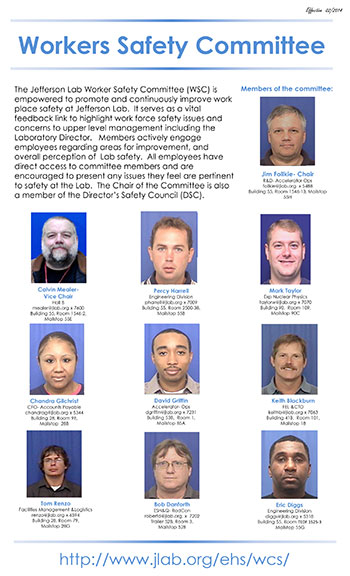 Jim Follkie, chair of Jefferson Lab’s Workers Safety Committee (WSC), has a message he wants to share with every member of the lab community: we’re here to help. Since 2001, the 10-member committee has met monthly to take up safety concerns from workers across the lab. But, despite its decade of involvement and improvements, many members of the lab community don’t fully understand the role it plays. The WSC serves as a vital communication link for highlighting workforce safety issues and concerns and as an additional way for those concerns to be addressed, according to Follkie. Everyone at the lab is empowered on a routine basis to deal with safety issues at any time, in any situation, and they know that they can take any type of safety concern or question to their supervisor, safety warden, division safety officer, ESH&Q, a Subcontracting Officer's Technical Representative (SOTR), or to any of the committees in place to handle topic-specific problems and questions. The WSC exists specifically to address safety issues that, for one reason or another, have not been mitigated, or which have come directly to the attention of its members. Each member of the WSC is a volunteer who has taken on the commitment and responsibilities of being on the committee, in addition to their regular work duties. They are all non-management employees and represent every major division in the lab. Committee members are selected by their peers for a two-year term. Terms are staggered intentionally so that the group's collective knowledge isn't lost and flows naturally from year to year. Fixed, rotating terms also provide a way for members to take the enhanced safety mindedness they gain while on the WSC back to their divisions and to the lab community at large. “Having the terms set up that way really helps,” Follkie noted. “The central, experienced unit is always there, but we also get the benefit of fresh sets of eyes for every situation. Having members drawn from across the lab also gives us much-needed diversity and true representation for the workers. We’re an essential resource for communication about safety in both directions – people can bring their concerns to us through our members; and we are a link up to the Director’s Safety Council as well.” As WSC chair, Follkie sits on the Director's Safety Council, which meets quarterly. And senior lab management, including Director Hugh Montgomery, is invited to the second half of every WSC meeting. Follkie, a chemical technician in the SRF (superconducting radiofrequency) group, said that seeing management’s involvement with the committee has been gratifying. “They’ve been wonderful,” he said. “Their position is always ‘What can we do to help you?’” Tina Johnson, ESH&Q staff administrator and the lab’s ESH&Q Reporting Officer, is a non-voting member of the WSC who serves as recorder for the committee. She maintains records of the WSC meetings and brings critical information to the committee when there have been safety incidents or reportable near-misses. “I help keep those lines of communication open,” she explained. “If we share with the committee, then they’ll share the information with others and with their supervisors.” While many safety issues that concerned construction and traffic flow have abated, new issues have replaced them. For instance, many workers are in new and not-yet-familiar surroundings and need to be mindful of moving differently in their new space. “Our message is, ‘Slow down and focus on what you’re doing,’” Follkie noted. Many of the issues the committee addresses come from the direct observations of its members. “They’re pretty gung-ho, and that’s a good thing,” Follkie said. “It can be harder to be safe, instead of taking the easier way out. But that’s how people get hurt.” Since June 2013, when Follkie became chairman, numerous safety challenges have been brought forward and addressed by the committee, among them: an 8-foot section of concrete was replaced after a person rolled their ankle; a trip hazard in a high-foot-traffic area was repaired; stop lines on the roads were repainted; and windows were installed in solid doors and some badge readers were moved to eliminate the chance of someone bumping their head on a door when bending over to get their badge read. Each member's role on the WSC goes far beyond monthly meetings. They are available by phone or email at any time for anyone at the lab with a safety concern that's not been satisfactorily resolved. Reporting an incident is almost as important as avoiding one, as Follkie knows all too well. Just before the Thanksgiving break in 2012, he fell as he was walking on the road between the Test Lab and the EEL when he tried to jump over a puddle on the side of the road. He knew he had to report it, but feared that the process would be onerous. It was, instead, straightforward and efficient. “The reporting process was easy, simple and non-judgmental,” he recalled. “No one was looking to place blame, and everyone I spoke with was genuinely concerned about my wellbeing, first and foremost.” According to Follkie, reporting minor incidents and near misses helps make us aware of new safety concerns and allows the lab to apply lessons learned before something small causes a bigger problem or an accident. And that, in the end, is what the Workers Safety Committee is about. “We don’t wait until someone gets hurt,” Follkie said in conclusion. “We’re there to be eyes and ears and a resource for any safety concern.” By Judi Tull Science Ed. Team Preps for Summer Interns; Seeks Student Projects, Mentors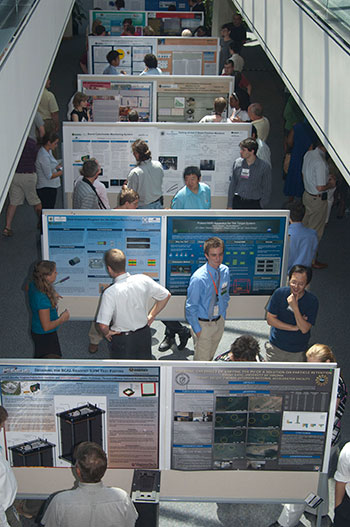 Jefferson Lab’s high school and college undergraduate summer interns develop posters explaining the project or research they worked on over the summer. The students get to discuss their work with the lab community during a poster session held on the last day of the summer programs. Summer will be here soon; and Jefferson Lab’s Science Education team is planning and preparing for the lab's 2014 summer science internship programs. The internship programs conducted each summer are designed for high school students and college undergraduates interested in finding out about or pursuing careers in STEM fields (science, technology, engineering and math). High School Summer Honors Interns These students have a strong academic record and are excited to have the opportunity to dive in and learn about the lab's science and technology, according to Brita Hampton, high school internship programs manager. The students are currently in the 11th and 12th grades and have expressed interest in pursuing scientific and technical careers. “Mentorship is a critical part of the learning experience for these high school students,” Hampton notes. Lab scientists, engineers and other technical managers who are interested in serving as a mentor to high-achieving high school students and have a project, or any number of small projects that can be accomplished over the summer, are asked to send to Hampton a description of the work to be assigned. Email Hampton@jlab.org or call her at ext. 7633 if you have questions. She needs ideas or proposals by May 1. The students will be required to develop a poster about their project and present it during a poster session on the last day of the program. College Undergrad Interns The Science Undergraduate Laboratory Internships (SULI) program is designed to provide undergraduates with valuable educational experiences that allow them to participate in mission-related research at Department of Energy facilities. The program is supported by the DOE's Office of Science, Office of Workforce Development for Teachers and Scientists. The Research Experience for Undergraduates (REU) program conducted at the lab is a partnership between Old Dominion University and Jefferson Lab, and is funded by a National Science Foundation grant. The REU program offers students direct access to laboratory equipment, facilities and staff through research experiences that aren't generally available on college campuses. Both give participants valuable educational, interpersonal and job-skills experiences by doing "real time" work in a laboratory setting, according to Surles-Law. "The programs immerse students in a scientific environment in hopes of encouraging them to pursue a career in a scientific or other high-tech field," explains Surles-Law. "Also, by exposing them to a research environment, we hope that many of them will return to this environment at some point in their careers.” Feedback from the interns has been very positive over the years, according to Surles-Law. "Nearly everyone has responded that the internship experience was very meaningful. We really enjoy seeing the students' progress over the course of the program. Many of them make noticeable advancements – academically, professionally and on an interpersonal level. It is thrilling to see a student go into a new environment and start absorbing it. They start to understand how they can produce something of value and how their efforts can make an impact," she continues. "They learn to handle responsibility and take their commitments very seriously." In 2012, a "Roads to Success" discussion between the students and a panel of lab staff was added to the agenda. The panel included a senior lab manager, a former intern, and representatives from a couple of the major divisions. Panel members shared their professional and personal experiences, and provided perspective and insight on their respective fields and career challenges. "This addition proved to be very popular with the students and was very well received," Surles-Law says. “I’m seeking volunteers to sit on this year’s Roads to Success panel.” The interns are required to develop a poster based on the work or research they conduct over the summer. "The interns must develop their posters and prepare so they can present and discuss their research and answer questions. They are expected to dress and present themselves professionally," she explains. "It is a rare opportunity for the students to do this – especially within a scientific community. The poster session is well worth the time and effort; it provides the students with a great experience and good material for a first CV (curriculum vitae). And, it gives them a finished product (the poster) that can be used for other events later in the academic year." The REU students also make oral presentations of their research projects to the faculty and students of the Physics Department at Old Dominion University. The SULI program is available to undergraduates at 15 of the DOE national labs. Jefferson Lab conducts its program over the summer, but many of the larger labs also offer spring and fall sessions. Students may participate in two SULI internships – both can be at the same lab or at different labs. Through the schools or programs they have been enrolled in over the years, several interns have gone on to doctoral programs and even postdoc positions affiliated with Jefferson Lab. Information about these internship programs is available at: http://education.jlab.org/indexpages/index.html Bridge Position Gives Scientist Best of Research and Academic Worlds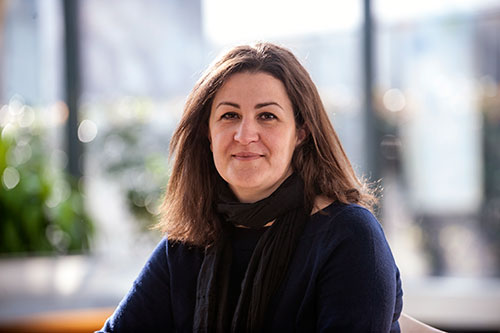 Jefferson Lab Staff Scientist Patricia Solvignon accepted a “bridge position” at the University of New Hampshire in 2013. The newly created assistant professorship was jointly created by the lab and UNH. For Jefferson Lab Hall C Staff Scientist Patricia Solvignon and her young family, five years of separation have come to an end. In the fall, Solvignon was named as an assistant professor at the University of New Hampshire, where her husband, Karl Slifer, a long-time researcher at Jefferson Lab, has a position. The couple’s two-year-old daughter, Anna, is finally getting to see both her parents, every day. Solvignon grew up in a French village of just 800 people where everyone knew everyone else and generations of families stayed close. Solvignon recalls visiting with her grandparents after school each day, playing with dolls and loving every minute of school. Her mom worked in a neighborhood restaurant and so was readily available if her daughter needed her. “It was,” she said, “the very best way to grow up.” She loved math, but struggled with writing. Teachers told her she had a lot of good ideas, but couldn’t quite put them together in words. Leaning toward her strong suit, she majored in math and physics in high school and then first set out to pursue a degree in math at Université Blaise Pascal in Clermont-Ferrand. Trouble was, she started to dislike how abstract math was becomingnd switched quickly to physics and chemistry. She received her degree in physics in 1998 and then her master’s the following year. The topic of her thesis was “Measurement of the production cross section of two Z bosons in the electron-positron annihilation at 189 GeV with the ALEPH detector at CERN.” She was always self-driven. She and her brother jumped right on their homework; no one had to tell them to study. And, for Solvignon, the extreme harshness of an elementary school teacher spurred her to even greater academic, emotional and independent heights. “He seemed to dislike certain kids in the class. I was chatty, for sure, but that was not a reason to put me for hours in the hallway almost every day,” she said, recalling the period. “For three years, he was rude and demeaning. But it made me strong. I vowed that no one would ever treat me like that again. I was surprised when I arrived in middle school that teachers liked me and congratulated me when I got good grades.” It was late in her schooling, she noted, before a professor (Jean-Claude Montret, LPC Clermont-Ferrand) praised her skills and encouraged her. “He told me, ‘You are made to do research,’” she recalled. “I was very surprised.” But pleased. Professors recommended that she come to the United States to do her Ph.D., but there was a problem: she was struggling with the level of English proficiency required by graduate schools. Physics is a small world, and there are, at times, solutions that are not immediately apparent. A researcher at Blaise Pascal, Pierre Bertin, talked to his friend Zein-Eddine Meziani at Temple University. “Zein-Eddine said, ‘You come here – take English classes – and then start your Ph.D. It will work out,’” Solvignon said. So she set out with two huge green suitcases and barely a smattering of English for Philadelphia, Pa. When she signed up for English classes at Temple, they told her it would take two semesters for her to become fluent. “I told them, ‘No! I don’t have that much time,’” she recalled with a laugh. In her typical, can-do fashion, Solvignon bought a television and watched episode after episode of “Friends” and “Seinfeld.” And that’s one of the ways she improved her English in less than a semester. Solvignon first came to Jefferson Lab to work on her thesis experiment in 2001. Although the culture shock of moving from Philadelphia to Newport News was significant, it was tempered by the fact that Slifer, whom she’d met at Temple, was already doing his own work at the lab. “He had been here about six months before I arrived,” she explained with a smile. “This city was a big change for me, but it was OK because Karl was here!” Her thesis, titled “Measurement of the 3He Spin Structure Functions in the Resonance Region: A Test of Quark-Hadron Duality in the Neutron,” was completed in 2006 with Meziani as her advisor, and she received a three-year post-doc position with Argonne National Laboratory under the supervision of John Arrington. One of those years was spent living in Chicago; the other two at Jefferson Lab working in Hall A. By 2009, she had become a staff scientist in Hall C and an affiliate professor with the University of New Hampshire, a role that allowed her to advise students but carried no salary from the university. The newly created assistant professor “bridge position” she now holds was jointly created by the lab and UNH and has given her the best of both worlds. “I am able to do my research at the lab and have a real teaching job at the university,” she said. Solvignon has an experiment that is scheduled to run in the upgraded CEBAF in 2015/16; it will investigate the isospin dependence of 2N- and 3N-SRC through the 3H/3H cross section ratio. She is also an active member of the lab’s Tritium Target Task Force that is working on a detailed design for the implementation of a safe, low-density tritium target. She is particularly excited about this work because it is the first time such a tritium study will done at the lab. Currently, she’s at the lab for about a week each month. Beginning this semester, she is teaching three days a week at UNH. By the time her experiment will run, she’ll be able to switch her schedule around to accommodate the work. Looking back over the years – including nine moves within the U.S. – Solvignon finds great joy in the evolution of her life. “I don’t think anything can bother me these days,” she said. “I wake up every day and can’t believe how good things have turned out. I got very lucky in my life.” By Judi Tull Lab Welcomes New Property Manager, C. Whalen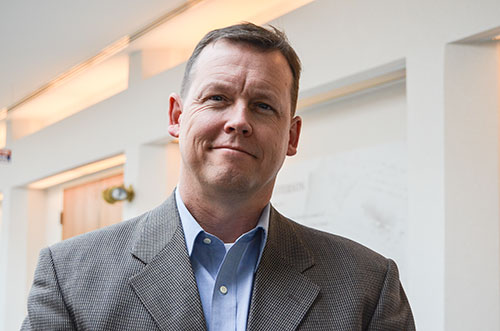 Christian Whalen was named Jefferson Lab’s new Property manager in December. He started working at the lab in May 2013 as a temporary contract employee. Born in Minnesota but raised between California and Florida for most of his youth, Christian Whalen could hardly have foreseen that his path would lead him to Jefferson Lab as its new Property manager. From 1993 to 1996, he was a recruiter in Florida. While serving there, he met the woman who would become his wife. He and Suzanne, who was working for a local police department at the time, were married in 1993. After the Army moved them to Germany, she learned the local dialect so well that she created and taught a class for Army wives on how to shop on the local economy. In 2001, he was assigned to Ft. Eustis and bought a house in Williamsburg. Their son, Caedmon, was born in June of that year. Whalen was then stationed at Ft. Hood, Texas, for a year, and then sent overseas, to Iraq, then to Bosnia, Kosovo, Macedonia and Germany again. During his second tour in Iraq in 2006, he recalls, looking around and saying, “That’s it. I’m done.” An assignment as the Support Operations manager for 800 troops deploying from Ft. Hood to Iraq provided him with valuable experience that now serves him well as the lab’s Property manager. He retired in 2007 at the rank of First Sergeant and secured a position as a contractor with Sikorsky Aerospace Maintenance, a division of United Technology Corp., working as site manager for the new Army UH-72 Lakota Helicopter. He was responsible for overseeing the building of a new site from the ground up, including scheduling aircraft for flight operations, and implementing all regulations and new policies and procedures. He received Sikorsky’s President’s Award for Excellence and was recognized for maintaining exceptional site profit margins in a time of shrinking budgets. Unfortunately, those budget cuts hit him personally in September 2012, when he was part of a reduction in force and found himself, for the first time in his life, without a job. Fortunately, Whalen and his wife had decided early on that they would “live lean” on his income alone and were able to weather that period. During that time, he also started working on his Bachelor of Science degree from Embry Riddle Aeronautical University, which he completed in 2012, and is currently halfway through a master’s degree program he started in 2013. In May 2013, he came to the lab on a temporary contract as a technical writer working with Bruce Lenzer, ESH&Q Division, to rewrite programmatic documents and standard operating procedures (SOPs) for the section – in order to realign them with new regulations from the Department of Energy. When that project was winding down, he applied for the Property manager position, which had been vacant since the death of Carl Iannacone. Whalen started work as the lab’s Property manager in December 2013. The Property Management department is tasked with identifying all controlled property, maintaining records and accountability, tracking inventory, ensuring that all sensitive property is assigned to an individual employee (property custodian), disposing of excess and surplus equipment, overseeing the inventory of precious metals, controlling the lending of Jefferson Lab equipment, and providing reports, training and guidance for everyone assigned to track and control property. “This is a very dynamic environment with a lot of moving pieces,” Whalen noted. “I’m leaning heavily on the experience of the people on our team.” Although being in a science-based environment is new for Whalen, he’s eased into the culture happily. “I’ve always been pretty technical,” he said. “And it’s fascinating to see so much raw science capability in one place – the sheer scale and scope and power. The amount of talent and brain power that’s here is amazing. One of the most interesting things is the different types of people who are here, from all over the world. Everyone focuses on their specialty but interacts and communicates with everyone else. The whole purpose of the entire lab community is supporting the work that matters [producing science].” With the recent changes and re-organization at the lab, some aspects within Property Management have shifted. “We are going to a leaner model,” Whalen explained, “with things like combining stock administration and property management.” He notes that the role of the Property Management department can sometimes be misunderstood. “Our intent is to provide good stewardship of the assets and money that the lab has been entrusted with,” he explained. “We’re not trying to be difficult – we are tied to certain rules for accountability, and we’re trying to help everyone we come into contact with. There’s a lot of responsibility on the part of the custodians of the equipment.” In his spare time, Whalen takes his son, who’s now 13, to Tae Kwon Do practice three or four times a week and hits the gym while Caedmon has his lessons. They also enjoy kayaking in the tributaries near their home. He recently answered the call for volunteers to help clean the CEBAF accelerator and spent a day in the tunnel. “I looked around and could hardly believe where I was,” he said. Looking back, Whalen marvels at where he’s been, what he’s done and this new pursuit. By Judi Tull Public Address System Successfully Tested Lab-wide on March 11Jefferson Lab used the March 11 statewide Tornado Drill as an opportunity to test its emergency communications systems and to roll out its new Public Address capability. This was the first lab-wide test of the Public Address tool, according to Bryan Hess, network manager. Carl Bolitho, networking engineer, did the technical work to make this capability available to the lab. Up to this point, the PA tool had been tested on a very limited scale. “We were ready for a lab-wide test of this system. It was great to have this test and determine that it is ready for use,” said Hess. The PA tool is potentially disruptive when it is activated, because it interrupts any in-progress call on a Cisco phone. Active calls are automatically put on “hold.” As soon as the PA announcement has ended, a lab person may re-activate the call by taking it off of “hold.” (This feature wasn’t activated for the March 11 test, but it is now active.) This capability is now a part of Jefferson Lab’s emergency communications systems and can be used for tornado and tornado warning advisories as well as for critical emergency situations. The PA tool won’t be used during the monthly Tornado Siren Test. However, Emergency Management plans to test and use the PA tool later this year during a Jefferson Lab emergency response exercise. “While it is beneficial to regularly test these communications tools to ensure functionality and to help familiarize members of the lab community with this additional emergency communication tool, we realize this particular tool could be very disruptive, so we will keep testing to a minimum,” Hess noted. “I’m excited to have this new capability available,” said Tina Menefee, Jefferson Lab emergency manager. “Communication in emergency situations is critically important, and I think this capability is a useful addition to our emergency communications systems.” Members of the lab community with feedback or observations regarding emergency communications may email their input to Jefferson Lab's Emergency Manager, Tina Menefee, at menefee@jlab.org. Milestones for January - February 2014Hello Goodbye These Milestone entries, listed alphabetically, are full-time, term, casual and student actions posted by Human Resources for January and February 2014. Jefferson Lab is currently seeking qualified individuals for a number of positions, including scientific, postdoctoral fellow, superconducting magnet engineers, safety, technicians and public affairs. All current employment opportunities are posted at: https://careers.peopleclick.com/careerscp/client_jeffersonlab/external/search.do Information about career opportunities at Jefferson Lab is available at: https://www.jlab.org/job-openings |
||||
|
The On Target newsletter is published monthly by the Thomas Jefferson National Accelerator Facility (Jefferson Lab), a nuclear physics research laboratory in Newport News, Virginia, operated by Jefferson Science Associates, LLC, for the U.S. Department of Energy's Office of Science. Possible news items and ideas for future stories may be emailed to jlabinfo@jlab.org, or sent to the Jefferson Lab Public Affairs Office, Suite 15, 12000 Jefferson Avenue, Newport News, VA 23606
|
||||


 If there is one theme to describe the monumental effort that led to the first successful operation of the newly upgraded CEBAF......
If there is one theme to describe the monumental effort that led to the first successful operation of the newly upgraded CEBAF......  Big changes are coming to the lot next door. The large triangle of land bordered by Hogan Drive, Jefferson Avenue and Oyster Point Road will soon be developed into a mixed-use neighborhood......
Big changes are coming to the lot next door. The large triangle of land bordered by Hogan Drive, Jefferson Avenue and Oyster Point Road will soon be developed into a mixed-use neighborhood......  John Arrington, the new chair of Jefferson Lab’s Users Group Board of Directors (UGBOD), has been a part of the lab community since 1993.....
John Arrington, the new chair of Jefferson Lab’s Users Group Board of Directors (UGBOD), has been a part of the lab community since 1993..... 